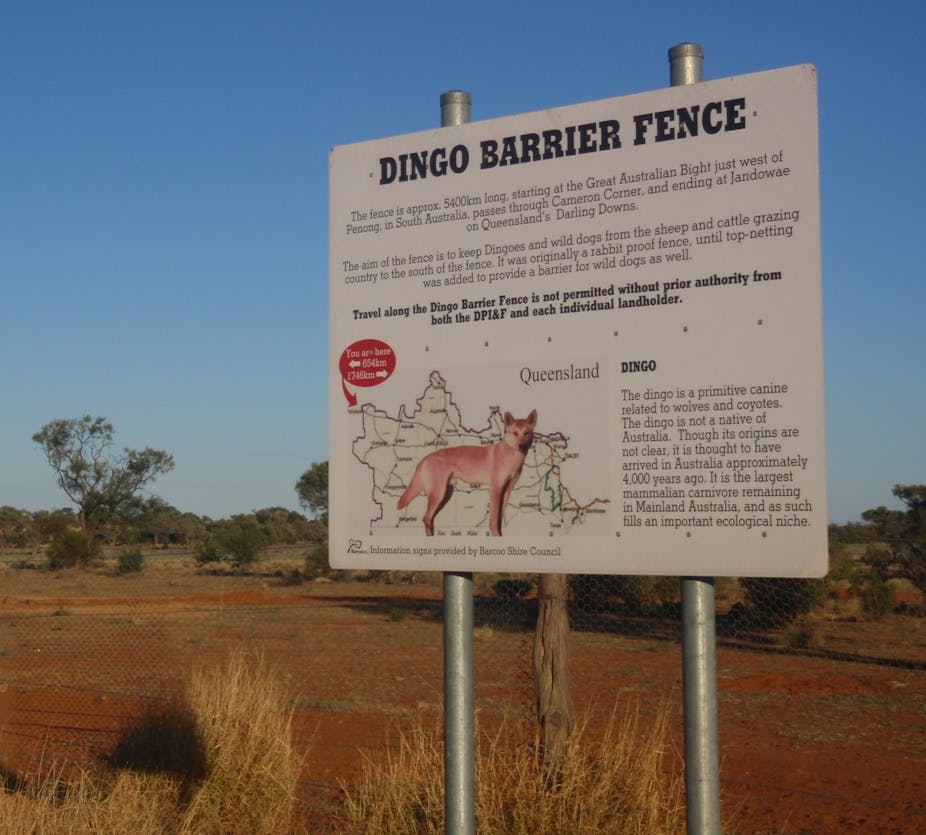Australia holds many world records, including the world’s longest fence, the dingo fence.
At 5,531 km, the dingo barrier fence stretches from eastern Queensland all the way to the South Australian coastline. The fence was erected in the late 1800s and early 1900s to protect cropland from rabbits. It was later modified to protect livestock, particularly sheep, from dingoes.
But there is increasing debate in the scientific community on whether the dingo fence is damaging the environment.
There is a simple solution, as we argue in a paper published today in the journal Restoration Ecology: move a small section of the dingo fence to test whether the dingo can help restore our degraded rangelands.
The longest fence in the world
The dingo fence is still actively maintained.
In South Australia, The Dog Fence Board administers and maintains the fence. A levy is charged to graziers to fund wages for maintenance and patrol workers. In Queensland the Wild Dog Barrier Fence Panel provides similar administrative assistance, as does the Wild Dog Destruction Board in New South Wales (NSW).

Dingoes are absent, or found in very low numbers, across much of central and western NSW, as well as parts of South Australia. There are also fences in Western Australia to exclude dingoes from the south-western corner of the state.
The dingo debate
The dingo fence has stirred a long-running scientific debate: does the exclusion of dingoes have detrimental effects on ecosystems?
One argument is that dingoes can keep in check smaller predators such as invasive red foxes and feral cats, in turn benefiting native species by reducing overall predation pressure upon them.
Dingoes may also control feral goats, as well as native herbivores such as kangaroos and emus, that together contribute to overgrazing when present in large numbers.
These are critical interactions to consider, because Australia holds another world record: the highest extinction rate for mammals over the last 200 years, with the loss of 29 endemic species. Predation by red foxes and feral cats are a common factor in many of these extinctions.
Reintroduce dingoes
One proposed solution to Australia’s extinction crisis is to restore populations of dingoes in areas where they have been culled or excluded. However, this proposal has met opposition, including from scientists.

In our new paper we argue that we can resolve the debate by moving the dingo fence around Sturt National Park in western NSW, on the border with Queensland and South Australia. The park is currently on the inner side of the fence, where dingoes are uncommon. Our proposal would put it on the outside, where dingoes are more common.
Western NSW is greatly degraded and suffers from eroded soils, impoverished native vegetation communities and unprecedented levels of extinction of native mammals and other vertebrates. So reintroducing dingoes could help start restoring these damaged lands.
There is reason to hope that they will thanks to studies on grey wolves in the United States.
Grey wolves were reintroduced into Yellowstone National Park and Idaho in 1995/96 after a 70 year absence. This provided scientists with an opportunity to explore what happens when a top-predator returns. The research has been integral in cementing the ecological theory known as a “trophic cascade”.
Studies are now being conducted outside of Yellowstone in more settled areas, including Washington State.
Moving the fence
We argue that a reintroduction study is possible to conduct under current legislation.
To undertake the study we estimate that 275 km of new dingo-proof fencing would be required. Monitoring costs would be in the order of A$1 million per year, which is about 10% of what is spent maintaining the dingo fence each year.
Such expenditure is not unprecedented for large-scale environmental projects in Australia. For example, the Australian Government recently provided A$19 million to reduce the detrimental impact of feral camels in central Australia, while A$35 million has been spent on the red fox eradication program in Tasmania.
The major prerequisite for the experiment to proceed would be convincing local communities to support the effort. That support would likely help to sway government policy, and garnering this support would require effective community engagement and extension.
Threatened species on borrowed time
There is an urgent need to develop bold solutions to help revive our native mammal populations.
We will not solve the mammal extinction crisis simply by repeating the same actions over and over.
To determine if the dingo can help, a dingo reintroduction experiment is the best way forward.


